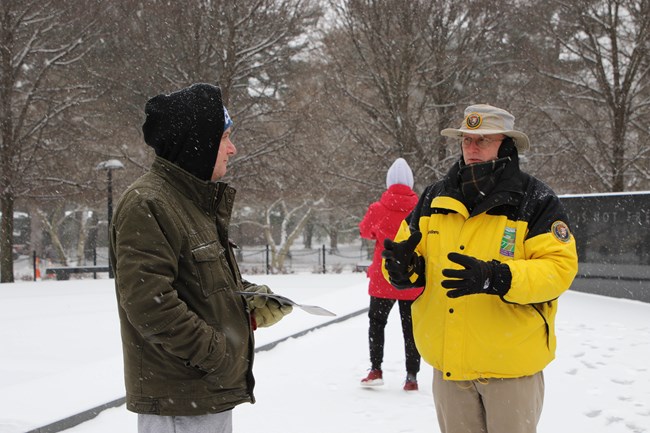Last updated: February 23, 2020
Article
Be Winter Ready For Your Adventure

NPS/Joshua Simas
When winter comes around, it brings with it the opportunity to experience parks in a whole new way. Colder temperatures can present its own set of risks and can make your trip challenging if you are unprepared. Whether you are hiking, driving, camping or participating in water-based recreation, don't let winter weather take you by surprise. Read on for more tips to Know Before You Go and While You Are at The Park
Know Before You Go
Restricted access and closures to some areas within a park are common during the winter months. Visit the park’s website or call ahead to get information on winter-related activities safety tips, and alerts on hazards, road conditions, and closures.
Be realistic about the increased difficulty level of traveling and recreating in the winter. Hiking on icy or snow-covered trails is much more difficult than hiking on a trail in the summer. If you have never planned a trip to a national park, check out the NPS Trip Planning Guide and always leave a trip plan with an emergency contact.
What is the difference between a watch, warning, and an advisory? Learn winter related terms, and know how to prepare for them.
If a winter related Advisory is issued, be aware. If a Winter Storm or Blizzard Warning is issued, take action.
NOAA
In addition to the 10 Essentials, research what additional gear you might need for your winter activity and test it before you go. For example, if you are:
- Recreating in water - you might need a dry suit.
- Hiking - consider wearing "over the shoe" traction devices to prevent slipping, sunglasses to protect your eyes from snow blindness, packing an emergency locator device, such as an avalanche transceiver, and an emergency blanket in case you get delayed by bad weather.
- Driving - research the park’s website to find out if you may need chains or snow tires. Always carry an emergency kit in your car in case it breaks down or if you have to wait out a storm. Your car emergency kit can include items like a snow shovel, ice scraper, sand/kitty litter, jumper cables, tow chains or ropes, extra water, and snacks.
Lengthy exposure to cold temperatures can lead to frostbite and hypothermia. Frostbite can cause a loss of feeling and color in the areas it affects, usually extremities, and severe cases can lead to amputation. Hypothermia is a serious health hazard that occurs when your body loses heat faster than it is produced and is no longer able to warm itself. Learn more about how to prevent, recognize and respond to cold related illness.
Warning signs of hypothermia include confusion, shivering, difficulty speaking and stiff muscles
NOAA
Adding layers will help keep you warm as the temperature drops
NOAA
You can regulate your body temperature and stay comfortable by dressing in layers that you can easily add, if you are getting too cold, and remove to prevent overheating. The right clothing can also reduce the risk of frostbite and hypothermia. Choose clothing made of wool or synthetic material over cotton. Cotton absorbs moisture easily and won’t keep you warm if it gets wet. Make sure to wear warm clothing including:
-
Insulating outer layer with a hood - a wind and waterproof jacket will keep out wind, rain and wet snow
-
Hat - heat is lost faster from the head
-
Gloves/Mittens - keep your fingers warm and prevent frostbite
-
Footwear - wearing wool socks and waterproof boots
Don’t forget to bring an extra set of dry clothing in a sealed bag, incase you get wet.
If you are participating in a water based activity, you are at an increased risk for hypothermia if you fall into cold water. Make sure to wear layers of clothing that will keep you warm and dry even if you get submerged.
Winter storms can greatly change the conditions of your planned route. Finding trails, blazes and signs can be difficult, and road conditions might be too dangerous to drive in. Familiar places can look very different when covered in snow. It is very important to have navigation equipment such as a compass and a map, as well as the skills necessary to use them. Keep in mind that a cell phone might not be reliable due to poor reception.
Certain mountain slopes may have a higher risk of an avalanche occurring during and after snow storms. Check in with local avalanche centers for forecasts and to learn if the park you are visiting has areas at risk for avalanches. Do your research and learn how to be aware of and prepared for an avalanche.
Learn more about how to be safe after a winter storm.

NPS / Victoria Stauffenberg
At The Park
Once you arrive at a park, stop by the visitor center or ask a ranger to get the latest information about park conditions, including specific locations with a high risk for winter weather hazards.
It is better to wait out a storm than to risk becoming lost or injured. Be prepared to stay out longer and adjust your schedule until weather conditions are better. Learn more about what to do if you are caught in a snowstorm.
One cross-country skier crests a hill with snow coming down while another skier is coming from behind
NPS/Neal Herbert
The breathtaking views and exciting adventures that National Parks offer do not stop when the temperature drops! Learn more about the different activities available at National Parks during the winter!
